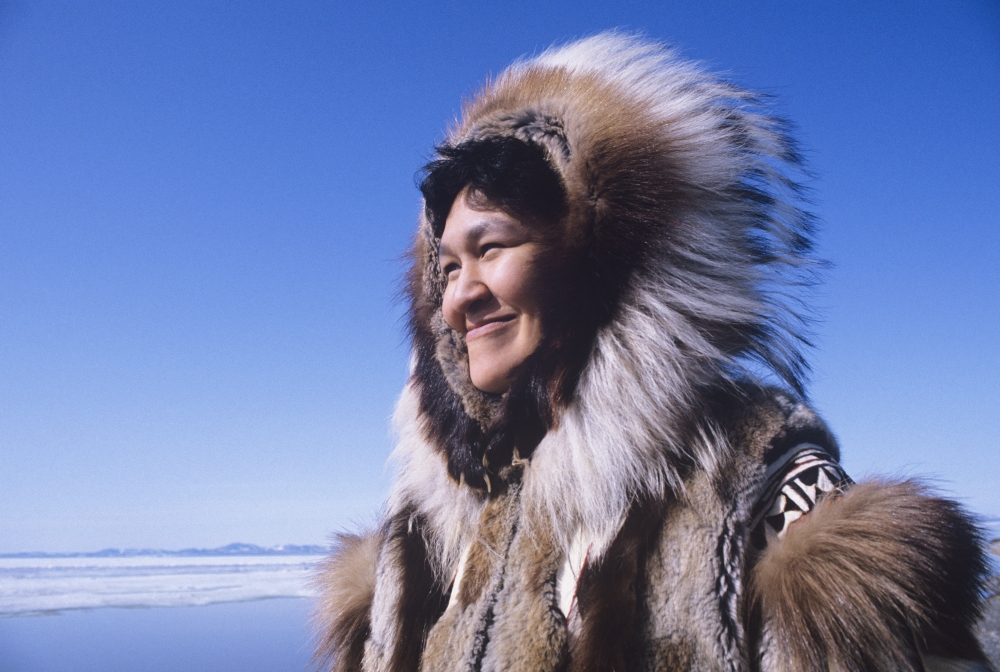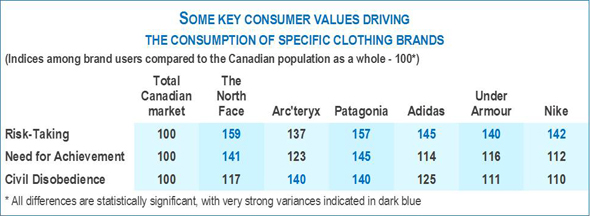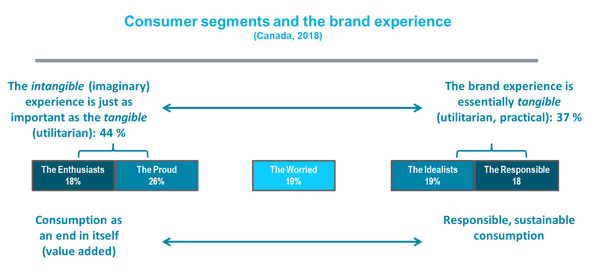Or branding: Value added or evil bait?

The power of brands
The topic of this week's blog post came to me after I had to create the table below. Even though I have been doing this job for more than 30 years, I am still fascinated when I encounter such phenomena!

When you look at this table, it is easy to see that these companies are selling much more than weather-appropriate clothing and accessories. Consumers who have purchased The North Face brand of products over the last year, for example, index much higher (at 159) on risk-taking to achieve their goals or simply to experience excitement! The same obtains for the need to set motivating and difficult challenges (at 141), and their willingness to bend rules and regulations to get what they want (at 117).
But what does a jacket or a pair of boots have to do with personal achievement and transgression?
That's exactly what the "brand experience" is all about. When you buy a brand's products, you are not merely fulfilling a utilitarian need. A brand is a promise, a guarantee, but also, more than ever, a lifestyle, a mental space.
The advertising and promotion done by the brands in the table above has been very successful in associating them in the minds of consumers with a lifestyle and motivations geared towards self-actualization (at the cost of taking risks and transgressing norms). These brands have managed to convince these consumers that wearing their brands lets them fantasize about the lifestyles and mentalities that these brands evoke. As if, just by wearing these clothes, they can join, in some small way, the ranks of the "transgressive achievers"! And it works! (Just read the indices on the table).
Not all consumers who wear the clothing of these brands share this kind of fantasy, but there are enough of them to indicate that the positioning of these brands is working perfectly.
And of course, we are paying for it! These brands can afford to charge more for their products because, in addition to clothing us, they make us dream and fantasize; they excite our imaginations! All that comes with a price tag!
Think of Jimmy Chin's exploits for The North Face or the myth surrounding Patagonia's founder Yvon Chouinard, or the political, controversial and provocative position of Nike, when they made a deal with NFL player Colin Kaepernick. Such techniques work perfectly to fire the imaginations of a substantial number of transgressive achievers across the country and incite them to buy clothing or accessories from these brands so that they can participate in and feel apart of these mythologies!
A social as well as market division
However, this is an issue on which citizens and consumers are divided, in this era of exaggerated consumerism versus moderation associated with financial and social responsibility.
It is undoubtedly due to the success of their advertising and marketing stratagems that companies are accused of creating needs and of "selling refrigerators to Eskimos"!
Many consumers (and citizens) will argue that if we already own practical clothing, companies are creating needs by offering new styles that we associate with seductive fantasy worlds. This brings us back to No Logo, the powerful book by Toronto journalist Naomi Klein (Random House, 1999).
In my November blog post on consumer segmentation in Canada, I showed how the distribution of consumer segments is perfectly aligned with this market and societal divide (based on the personal values of this segmentation). More than two Canadian consumers out of five (44% and exactly the same proportion in Quebec), whom we dubbed The Enthusiasts and The Proud, revel in brand mythologies and want their experiences to reflect the brands' symbolism, imagery and fantasy.
On the other hand, nearly two out of five Canadians (37% and, again, the same proportion in Quebec), The Idealists and The Responsible, vehemently denounce the creation of false needs by brands in order to make us buy, which increases our carbon footprint and the amount of waste we produce.
Located between the two extremes, The Worried (19%) select their purchases solely on price, and are less sensitive to the symbolic universe of the brands, although they are not adverse to comfort as a purchasing criterion.
Thus, we find a marked split between those who are sold dreams along with practical considerations and those who are scandalized and denounce the creation of false needs.
The table blow clearly illustrates this split, while recalling some details of my November blog post ...

In the defense of dreams
Allow me to take a position here, even at the risk of making enemies or being accused of being a mouthpiece for the brands, given that I have been earning my living helping them to create and maintain their mythologies (notably, with the help of all these consumer values and hot buttons).
The question is: Why shouldn't the emotional gratification created by the mythological universe of a brand be as legitimate as the practical use of a product? For example, when I wear a coat from The North Face, I feel a bit like a bold mountaineer when I "climb" the main staircase up Mount Royal at the end of Peel Street in Montreal, and the coat still costs less than a trip to Mount Meru in the Himalayas (and it is certainly less risky, even if the brand experience makes me fantasize about the risk - some people find the main staircase up Mount Royal rather daunting, just the same!).
We will never stop people from fantasizing, from imagining at times that they are superheroes or whatever else. Even if brands do facilitate these imaginary trips, it is still better than taking drugs! My example was clothing, but these types of symbolic mechanisms are at work in all types of markets.
The health of our economies depends primarily on domestic consumption, and the strength of the brands supports this. But this strength comes from their mythologies. Each brand must create and maintain a mythology, in symbiosis with the values of its consumers (the same obtains for ecologists).
Brands and social responsibility
That said, brands can make us dream at the same time as encouraging responsible consumption practices. Think of Patagonia, which tells consumers not to buy clothes if they do not need them. This brand even encourages us to repair our coats with duct tape instead of buying a new one (note that, of all the brands, Patagonia does the most to encourage fantasizing).
For me, I find "the dream" less of an issue than a brand's ethical codes and practices of corporate social responsibility. Brands must incorporate social responsibility practices in their commercial activities, since consumers are increasingly demanding it.
If they do it right, if they do it seriously and authentically, the dream component will become more and more socially acceptable and legitimate.
P.S.: Very sad news ...
Last week, The North Face announced the death of three of its mountain climbers, who were attempting to ascend the face of Howse Peak, the highest mountain in the Waputik chain of the Canadian Rockies. Their bodies were recovered on Sunday, April 21. Austrians David Lama and Hansjörg Auer and American Jess Roskelley went missing on April 17 following an avalanche.
These mountaineers were part of The North Face's Global Athlete Team, athletes who help promote the brand's mythology. The face of Howse Peak is very isolated and difficult to climb. They took risks and, this time, luck was not on their side.